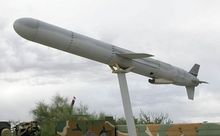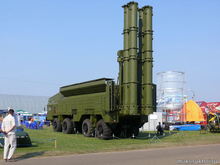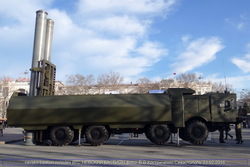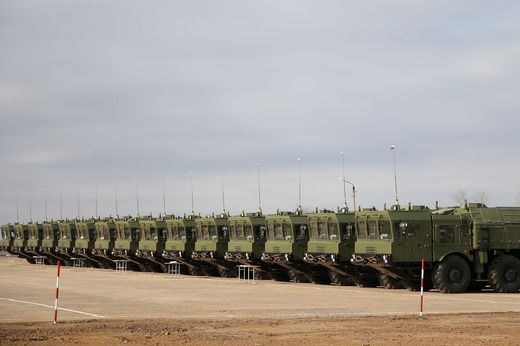The situation with the INF Treaty is getting worse pretty rapidly. U.S. Congress is moving to include what is known as "INF Treaty Preservation Act" in the National Defense Authorization bill. Judging by the language of the bill, its authors believe that the best way to preserve the INF Treaty is to join Russia in killing it (and to kill the New START extension for good measure). The current version of the bill would establish a U.S. program to develop an INF-range ground-launched cruise missile development program. Other proposals have been circulating as well - the Senate version of the INF Preservation Act mentions active defenses, counterforce capabilities, or things like "facilitating the transfer to allied countries of missile systems with [INF] ranges" (I am told that the plan is that the missiles would come from Israel). And it's not just Congress -- the Pentagon has already developed a set of five or so options that would address the INF violation (Israeli missiles is reportedly one of them).
In short, the process that would lead to destruction of the INF Treaty has been set in motion and at this point fewer and fewer people mention the option of resolving the issue through a discussion with Russia. In fact, a lot of people do not particularly care about the details of the alleged violation or its real military significance. For them, it is very convenient to start with a "blatant treaty violation" and move on to their favorite cause, be that missile defense, dismantlement of New START, or something else.
This is very unfortunate, to say the least. I remember the time when the administration officials were struggling to come with a plan that could be presented to the Congress as a tough response to the alleged violation, but that would not go much beyond business as usual. Apparently, the judgement was that the violation would not make much difference in terms of a military threat. But that was a couple of years ago. Since then the "blatant violation" narrative took hold and the discussion is driven by those who want to "preserve" the INF treaty by killing it together with much of the arms control process.
A good case can be made that the Obama administration mishandled the case. Yes, it was under serious pressure from the Republicans to do something about the suspected violation. Given the circumstances, it did not have much of a choice but to confront Russia and file a formal accusation in the 2014 Compliance Report. But it was wrong to withhold the details for that long after that. The current administration may still release some data, but it may be too late - this snowball can easily destroy the INF treaty and take the New START with it. If this happens, part of the blame will be on the Obama administration.
I believe that it is still possible to resolve the issue without wrecking the arms control process. If the United States is serious about preserving the INF and New START treaties, it should take steps to preserve them. And these steps do not include development of its own INF-range missiles not to mention deploying such missiles in Europe. I can see why people hope that something like the "dual track" decision of the SS-20 days would work this time around, but I am not sure it will. Besides, imagine getting allies to support the dual track decision without telling them anything about SS-20.
This is exactly the problem at this point--the United State so far has failed to make a convincing case that the violation is serious. Russia, of course, strenuously denies any wrongdoing, but that is something you would expect it to do in a situation like this. But even U.S. NATO allies do not seem to be fully on board with the United States. I don't remember any European leader making a strong statement about Russia's alleged violation. The United States has briefed its NATO allies, of course, but people that were at these briefings tell me that they didn't get an impression that there is much there there.
The bits and pieces that are publicly known suggest an outline of a case, but they also leave enough questions unanswered to give Russia plenty of room for maneuver. And Russia seems to be perfectly fine with that.
So, what do we know about the violation? Here is my attempt to collect various bits of the puzzle and see if this can help better understand the situation. At this point I have to admit that it is probably not a "technicality," although it is still a case of dealing with some subtle technical points of the INF treaty. Comments and suggestions would be very much appreciated.
There is a general agreement that the INF culprit, known as SSC-8, is somehow related to the Kalibr sea-launched cruise missile, which we know has the INF range. (SSC-8 is often referred to as 9M729, but I'm not sure it's been established that these are the same missile, so I'll use SSC-8 to identify the missile in question.) Kalibr itself is a member of the 3M14 family of cruise missiles that includes missiles of all kinds, including an MTCR-compliant 3M14E/Club with reported range of 300 km. The Kalibr-NK version (NK stands for "surface ship" here) was said to have range capability of up to 2600 km. Another long-range version of the missile that was also mentioned earlier is 3M14S, where S may stand for "strategic." The SSC-7/R-500 missile of the Iskander-M system also appears to be a member of the 3M14 family.
One problem here is that the 3M14 family is big enough, so the fact that SSC-8 belongs there doesn't tell us much about it. One significant parameter is the length of a missile. While shorter-range 3M14E and SSC-7/R-500 are about six meter long, Kalibr-NK is a bit over eight meters. It is reasonable to assume that SSC-8, which is believed to have a range of about 2000 km, is also an eight-meter long missile. But the available evidence is not conclusive - I don't think we can rule out a possibility that SSC-8 is a short six-meter long missile. More about it later.
What we know is that the missile that became SSC-8 was undergoing flight tests since about 2008 and that until the end of 2011 the program looked like a SLCM development program. The INF Treaty does not prohibit development or testing of long-range SLCMs (or ALCMs) as long as they are tested in a certain way (Article VII.11):
A cruise missile which is not a missile to be used in a ground-based mode shall not be considered to be a GLCM if it is test-launched at a test site from a fixed land-based launcher which is used solely for test purposes and which is distinguishable from GLCM launchers.
However, in the end of 2011 the United States "had indications that this missile was a missile of concern." About the only way a test program would trigger a concern was to begin tests from a "mobile land-based transporter-erector-launcher." Strictly speaking the launcher doesn't have to be mobile (see Article II.4) but in this case it definitely was (since it has a "chassis designator"). The tests would mean that the missile is a GLCM and not a SLCM in development. Being a GLCM is not enough, though. To become "a missile of concern" this GLCM would have to have an INF range (which is between 500 and 5000 km).
Now, the tricky part is that there are a number of ways to determine if a test involves a cruise missile with an INF range. The INF Treaty does not, in fact, require a GLCM to demonstrate its range in a test. Here is what Article VII.4 says:
The range capability of a GLCM [...] shall be considered to be the maximum distance which can be covered by the missile in its standard design mode flying until fuel exhaustion, determined by projecting its flight path onto the earths sphere from the point of launch to the point of impact.
Of course, if a test demonstrates that the missile can actually cover more than 500 km, the case would be clear. But it appears that SSC-8 has not been tested at full range (from a ground-mobile launcher).
The evidence of that is circumstantial, but the 2017 Compliance Report says that (emphasis added) "the violating GLCM has a range capability between 500 and 5,500 kilometers." Also, the only SSC-X-8 test described in open sources, the one in September 2015, was a test within the treaty limits. That story said that (emphasis added) "intelligence analysts reported that the missile's assessed range is between 300 miles and 3,400 miles." My guess is that had the missile demonstrated 500+ km range in one of the GLCM-mode tests (i.e. from a ground-mobile launcher) the language would have been different.
Absent a full-range test, one can estimate the range capability based on the missile outlook, but that is not a particularly reliable route (it didn't work very well with the Backfire bomber back in the day). It would work, however, if the missile tested from the mobile launcher is (almost) identical to the one that was tested at an INF range from a fixed launcher.
This seems to be exactly what happened. I was told that the information that the Unites States gave to Russia at the early stages of the dispute included a description of two tests--first, the missile was tested from a treaty-compliant launcher (fixed land-based used for SLCM tests) and then, a a few days later, it was tested again, from a noncompliant one (land-based mobile).
This kind of evidence eventually led the United States to conclude that the missile that was tested from a mobile launcher, which is now known as SSC-8, has the range capability between 500 and 5,000 km and therefore is a violation of the INF treaty.
Presented like this, this evidence does not seem to leave Russia much room for maneuver. But it still insists that it is in full compliance with the INF Treaty. And, strictly speaking, there might be a way for Russia to claim innocence. If there was no full-range tests from a land-based mobile launcher, which as discussed earlier appears to be the case, Russia can plausibly claim that the missile that it tested from a mobile launcher, SSC-8, is in fact different from Kalibr (or whatever missile was tested at full range as a SLCM).
This is probably what Russia is counting on. The 2017 Compliance Report list this item in the list of information that the United States gave to Russia (emphasis added):
Information on the violating GLCM's test history, including coordinates of the tests and Russia's attempts to obfuscate the nature of the program;
The "attempts to obfuscate" might be a small modification of the missile, different designation, or something like that. Apparently Russia believes that these attempts have been successful.
 Unfortunately, the INF treaty does not say much about how one can tell one cruise missile from another. The general approach is that different missiles should be distinguishable from each other (this is used for launchers in Article VII.11). There must be a way, though--back in the 1980s the United States and the Soviet Union did distinguish between sea-launched and ground-launched versions of the Tomahawk cruise missile, even though they are essentially the same missile.
Unfortunately, the INF treaty does not say much about how one can tell one cruise missile from another. The general approach is that different missiles should be distinguishable from each other (this is used for launchers in Article VII.11). There must be a way, though--back in the 1980s the United States and the Soviet Union did distinguish between sea-launched and ground-launched versions of the Tomahawk cruise missile, even though they are essentially the same missile.
The U.S.-Russian discussion, however, does not seem to get to the point of discussing differences between missiles. Most likely Russia just states that it is in full compliance with the treaty and there is nothing to discuss here. Ironically, this is more or less how the United States treats Russian concerns about the Mk-41 launcher deployed as part of the AEGIS Ashore. As I discussed earlier, the deployment of AEGIS Ashore is probably not a violation of the treaty. However, it is not unreasonable to ask the United States to demonstrate that these launchers are distinguishable from those that are used to launch SLCMs or (back in the day) GLCMs. As I understand, the reason the United States balks at that request is that the difference, while exists, is not particularly large and one would have to get inside the launcher and/or its control equipment to demonstrate it. So, the United States just says that there is no problem there and we should trust it that the AEGIS Ashore Mk-41 launchers cannot launch cruise missiles. That's not that different from the position taken by Russia.
So, we appear to be stuck here, with both sides claiming full compliance and with no mechanism in the treaty to unblock the stalemate. About the only thing that could help at this point is an open discussion of the alleged violation. If the Unites States believes its has convincing evidence, it should show it. U.S. reluctance to go public with detailed description of its accusations is only adding to the suspicion that its case is not particularly strong.
We know that at this point it is not about protecting methods and sources -- the United States already gave Russia quite a bit:
- Information pertaining to the missile and the launcher, including Russia's internal designator for the mobile launcher chassis and the names of the companies involved in developing and producing the missile and launcher;
- Information on the violating GLCM's test history, including coordinates of the tests and Russia's attempts to obfuscate the nature of the program;
Since Russia already has all this information, what's the harm in releasing it publicly?
Information about the launcher would be particularly helpful. It appears that SSC-8 has a launcher that is different from a standard Iskander-M TEL. The question is, how different? It would depend on whether SSC-8 is a six-meter or eight-meter long missile. If it's a "long" TEL, capable of carrying an eight-meter long missile, SSC-8 is probably closer to Kalibr-NK, which means that it is more likely to be an INF-range missile.
It is also possible that we are dealing with a "short" TEL, which would suggest a missile that is closer to SSC-7/R-500. In this case it would be a bit more difficult to make a case that the missile has the range prohibited by the INF treaty. But probably not impossible.
So far, there is no strong evidence one way or the other. We have a New York Times story from February 2017 that says that the launcher "closely resembles the mobile launcher used for the Iskander" seemingly attributing this statement to Gen. Breedlove, who is also quoted as saying that "This will make location and verification really tough." But "closely resembles" may mean different things in different contexts.
There is also some evidence that "The SSC-8 launcher is longer [than Iskander] and has a hump." Hans Kristensen's sources are usually reliable, but here it is not clear how long is "longer." And the hump could be there just because the launcher carries more than two missiles, like this one:
 Right now, there are a number of theories about the TEL. One suspect is the TEL known as 9P701 - this designation appeared in the Titan-Barrikady Design Bureau's acquisition plan for 2016. Titan placed an order of eight MZKT 7930-200 chassis to produce four 9P701 TELs and four 9T256 supply vehicles (it also ordered 48 chassis for regular Iskander-M 9P78-1 TELs and 9T250 supply vehicles). A standard Iskander missile brigade includes 12 TELs, but a basic unit, a battalion, has exactly four launchers. It is theoretically possible that these four 9P701 TELs were then used to equip the 119th missile brigade when it received its new equipment in November 2016 at Kapustin Yar (see the image on top of the post).
Right now, there are a number of theories about the TEL. One suspect is the TEL known as 9P701 - this designation appeared in the Titan-Barrikady Design Bureau's acquisition plan for 2016. Titan placed an order of eight MZKT 7930-200 chassis to produce four 9P701 TELs and four 9T256 supply vehicles (it also ordered 48 chassis for regular Iskander-M 9P78-1 TELs and 9T250 supply vehicles). A standard Iskander missile brigade includes 12 TELs, but a basic unit, a battalion, has exactly four launchers. It is theoretically possible that these four 9P701 TELs were then used to equip the 119th missile brigade when it received its new equipment in November 2016 at Kapustin Yar (see the image on top of the post).
This would also be largely in agreement with the same New York Times story, which quoted administration officials as saying that
the Russians now have two battalions of the prohibited cruise missile. One is still located at Russia's missile test site at Kapustin Yar in southern Russia near Volgograd. The other was shifted in December from that test site to an operational base elsewhere in the country [...]
The battalion at Kapustin Yar would be that in the 119th missile brigade, the other one would be in the 20th missile brigade, based in Spassk-Dalniy, Primorsky krai, which received its missiles in June 2016. The 119th brigade was transferred to its permanent base in Yelanskiy, Sverdlovsk oblast in April 2017 - the video account does not show any TELs that would be different from others, but we don't see all the vehicles.
The 9P701 story seems to suggest that there is an upgrade of Iskander's SSC-7/R-500 cruise missile that uses a new TEL. Dmitry Kornev of MilitaryRussia.ru noted a 2015 story about a new missile for Iskander developed by NovatorKBM. The story doesn't say much, but this might be just the missile that uses the 9P701 TEL. What is not clear is whether it has anything to do with SSC-8. But it might. In this case we are probably dealing with a six-meter long missile. (UPDATE 07/02/2017: It turns out that that particular missile is a ballistic missile. Besides, it's not Novator. It is still possible that there is an upgrade of the cruise missile as well, but it is not related to that KBM story.)
 There is another theory as well, although it is not supported by much in terms of evidence. Frankly, it's just a guess that should be treated as such. It is possible that SSC-8 TEL does not look like that of Iskander at all and in fact is closer to the Bastion launcher, which is large enough to accommodate an eight-meter long missile. This is where "names of companies involved" would help identify the launcher - unlike Iskander TEL, these launchers are not produced at Titan-Barrikady in Volgograd.
There is another theory as well, although it is not supported by much in terms of evidence. Frankly, it's just a guess that should be treated as such. It is possible that SSC-8 TEL does not look like that of Iskander at all and in fact is closer to the Bastion launcher, which is large enough to accommodate an eight-meter long missile. This is where "names of companies involved" would help identify the launcher - unlike Iskander TEL, these launchers are not produced at Titan-Barrikady in Volgograd.
So, the first order of business should be to release information about the alleged violation that the United States has already shared with Russia--"internal designator of the chassis," "names of companies involved," and of course, the history of tests and obfuscation efforts. This should be enough to get a much better sense of what is the nature of the violation, how serious it is, and what can and should be done about it.
The next step should probably involve an invitation to discuss "distinguishable characteristics" of various missiles and launchers. This would require the United States to indicate its readiness to talk about the differences between the AEGIS Ashore Mk-41 launchers and those that are used to launch SLCMs. This would not mean admitting that Russia's counter-accusations have merit; it could, however, help initiate a technical discussion that might bring some clarity to the issue. Again, I remember time when U.S. administration officials were saying that they would be okay if Russia just admits the problem.
It may well be that it is too late to save the INF treaty. But we should also be clear that the real threat to the treaty does not come from two battalions of long-range GLCMs. Russia is busy deploying its Kalibr cruise missiles on all kind of ships and submarines. In terms of numbers and range capability these would be a much more significant factor in any potential conflict in Europe, especially since these missiles are clearly nuclear capable. Note also, that Russia never formally agreed that long-range sea-based cruise missiles are tactical weapons, so they are not covered by the unilateral pledges of the early 1990s or any arms control agreement. One can argue that GLCMs are less vulnerable than submarines and especially surface ships, but I don't think it is a very convincing argument.
This is not to say that a suspected violation of a major arms control treaty is something to be taken lightly. But the dispute about INF treaty provisions should not distract from the fact that even though GLCMs are problematic they are far from the biggest threat to security and stability in in Europe. Or maybe it is. But if that's the case, we should be able to see the evidence and discuss it publicly. I hope it is not too late yet to have an informed discussion of the issue.


Comments
Unclear to me who is the advocate in the United States for continuing the INF Treaty in the face of Russian violations. (real or assumed) The Trump Administration, and in general, the Republican Party seem indifferent. The opposition Democratic Party doesn’t seem to recognize this as a real issue; no strong supporters of INF have emerged from the Democratic Congress leadership. Impossible to believe that if the INF Treaty is abolished, there would be support for a New START extension in February 2021. The world of arms control hangs in the balance. The only small voice of reason seems to be coming from, ironically, the Pentagon who believe INF and New START are not only necessary but, in fact, are very advantageous to the US. However, those policy wonks are middle management; powerful voices on US military policy but non-political and sit just below the presidential appointed senior leadership. Will the Pentagon’s voice be heard? A bigger question is, who is talking to the Russians? Does Russia see value in INF? Does Russia even want a New START extension?
Something will have to change before I have any confidence this issue can be resolved.
Frank Shuler
USA
Well, Russia is on record saying that it wants the INF treaty to stay. That's a start. It will be difficult to resolve the violation issue, but not entirely impossible.
The eleventh brigade set is transferred to the Russian Army:
http://www.redstar.ru/index.php/newspaper/item/35184-o-resursakh-oboronnogo-znacheniya
...and it will be the Guards missile Brest-Warsaw Red Banner brigade in the Kaliningrad region:
https://yaostrov.ru/corps/novosti/item/50314-гвардейская-ракетная-бригада-отмечает-75-летие